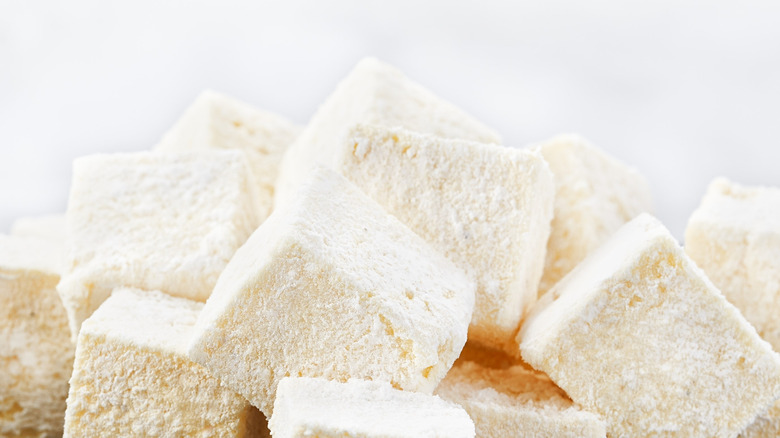Why It's Almost Never Worth It To Make Your Own Marshmallows
Whipping up a stack of marshmallows is like a science lesson. You need to follow the method thoroughly, observe changes in your ingredients, and use tools, like a thermometer, to create the perfect pillowy batch. And even with all those measures in place, you can still end up with a chalky mass instead of a cushiony white treat that's soft and tender in the center. If you aren't a culinary geek who likes to tinker with new recipes and techniques, you might be better off purchasing store-bought marshmallows to avoid the hassle.
Firstly, making marshmallows involves assembling a super-hot syrup with glucose, sugar, and water, which can be a dangerous activity if you haven't worked with syrups before. This mixture has to reach 240 degrees Fahrenheit before it's slowly trickled into a dissolved gelatin mixture in a steady stream. While you can take plenty of steps to safeguard yourself from the hot liquid, there is a risk of it splattering or bubbling up as you pour.
Secondly, you'll need to use a candy thermometer to check that the syrup has reached the correct temperature before you add it to your gelatin. The likelihood is that unless you regularly make things like jams and preserves that require a temperature gauge, you won't have a candy thermometer lying around in your utensil drawer. Having said this, if you want to create customized flavors, like these homemade raspberry marshmallows, and see yourself using a candy thermometer more often in the future, it might be worth the investment.
Squishy homemade marshmallows are tricky to cut into neat squares
As marshmallows are mostly made of sugar and whipped air, they can be very sticky and difficult to cut into neat pieces due to their bouncy nature. Store-bought marshmallows are portioned out in factories, where a sharp blade cuts them into identical nuggets, but mimicking this process at home is a tricky task. However, you can spritz your knife with cooking spray before making each cut to prevent the squishy mallow from adhering and dragging. Another option is to use a plastic knife, which has a naturally non-stick surface (this hack makes cutting brownies a breeze, too).
Store-bought marshmallows can last for months in their packaged and unopened state, but homemade marshmallows have a relatively short shelf life of three weeks. Once the air gets to them, their internal moisture migrates into the atmosphere, turning the surface hard, chewy, and stale. You'd be better off stashing a few bags in your pantry, rather than making your own, if you want to enjoy them in their softest and freshest state.
Finally, it's not always the case that homemade treats and candies taste better than store-bought. For example, in our taste test of the best store-bought marshmallows, Dandies marshmallows boasted the perfect balance of sugar and vanilla. This affordable treat was also satisfyingly firm and free from artificial colors or flavors.

